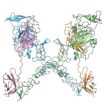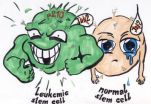(Press-News.org) Symmetry is an inherent part of development. As an embryo, an organism's brain and spinal cord, like the rest of its body, organize themselves into left and right halves as they grow. But a certain set of nerve cells do something unusual: they cross from one side to the other. New research in mice delves into the details of the molecular interactions that help guide these neurons toward this anatomical boundary.
In an embryo, a neuron's branches, or axons, have special structures on their tips that sense chemical cues telling them where to grow. The new findings, by researchers at Memorial Sloan Kettering Cancer Center and The Rockefeller University, reveal the structural details of how one such cue, Netrin-1, interacts with two sensing molecules on the axons, DCC and a previously less well characterized player known as neogenin, as a part of this process.
"Our work provides the first high-resolution view of the molecular complexes that form on the surface of a developing axon and tell it to move in one direction or another," says Dimitar Nikolov, a structural biologist at Memorial Sloan Kettering. "This detailed understanding of these assemblies helps us better understand neural wiring, and may one day be useful in the development of drugs to treat spinal cord or brain injuries."
In a developing nervous system, the signaling molecule, Netrin-1, identified by Rockefeller University Professor Marc Tessier-Lavigne and colleagues, can guide neurons by attracting or repulsing them. In the case of axons that cross from one side to the other, extended by so-called commissural neurons, Netrin-1 attracts them toward the middle.
With a technique that uses X-rays to visualize the structure of crystalized proteins, research scientist Kai Xu and colleagues in Nikolov's laboratory revealed that Netrin-1 has two separate binding sites on opposite ends, enabling it to simultaneously bind to different receptors. This may explain how Netrin-1, which is an important axon-guiding molecule, can affect in different ways neurons that express different combinations of receptors, Nikolov says.
For some time, scientists have known commissural neurons used the receptor molecule DCC to detect Netrin-1. Neogenin has a structure similar to DCC, and this research, described today in Science, confirms neogenin too acts as a sensing molecule for commissural neurons in mammals.
In experiments that complemented the structural work, conducted by Nicolas Renier and Zhuhao Wu in Tessier-Lavigne's lab, the researchers confirmed that, like DCC, neogenin senses Netrin-1 for the growing commissural neurons in mice.
These neurons are part of the system by which one side of the brain controls movement on the opposite side of the body. As a result, a mutation in the gene responsible for DCC interferes with this coordination, causing congenital mirror movement disorder. People with this disorder cannot move one side of the body in isolation; for example, a right-handed wave is mirrored by a similar gesture by the left hand.
The work also has implications for understanding why DCC, neogenin and other cell-surface receptors come in slightly different forms, called splice isoforms. The structural research revealed these isoforms bind differently to Netrin-1. However, it is not yet clear what this means for neuron wiring, Nikolov says.
"With this structural knowledge, and with the identification of an additional receptor involved in axon guidance in the spinal cord, we are gaining deeper insight into the mechanisms through which neurons make connections that produce a functioning nervous system, as well as the dysfunction that arises from miswiring of connections" says Tessier-Lavigne.
INFORMATION: END
Research details how developing neurons sense a chemical cue
2014-05-30
ELSE PRESS RELEASES FROM THIS DATE:
Study highlights side effects felt by BRCA mutation carriers after cancer risk-reducing procedure
2014-05-30
PHILADELPHIA — The majority of women with cancer causing BRCA1 and BRCA2 mutations experience sexual dysfunction, menopausal symptoms, cognitive and stress issues, and poor sleep following prophylactic removal of their Fallopian tubes and ovaries - a procedure known as risk-reducing salpingo-oophorectomy (RRSO) - according to results of a new study from the Abramson Cancer Center and the Perelman School of Medicine at the University of Pennsylvania. The team's findings, which reaffirm the need for a better understanding of how to manage long-term effects of the risk-reducing ...
Can narcissists be moved to show empathy?
2014-05-30
Researchers at the University of Surrey and the University of Southampton have investigated whether narcissists can elicit empathy for another person's suffering. It has been well documented that narcissists lack empathy, but why is that the case, and do they have the capacity to change that behavior? The research is published in Personality and Social Psychology Bulletin.
Characterizing narcissism
When we think of narcissism most of us can all think of a colleague, friend, or former significant other that would fit the description; "A bit full of themselves, self-centered, ...
Narcissists can feel empathy, research finds
2014-05-30
Narcissists tend to lack empathy, which can cause problems for themselves, the people around them and society in general. However, new research published today from the University of Surrey, suggests that with the right focus, people with narcissistic tendencies can feel empathy for another person's suffering. This may be important in helping to prevent the often violent or anti-social behaviours that some narcissists are prone to and the crimes that are committed as a result.
The research, published in Personality and Social Psychology Bulletin, studied participants ...
Eating prunes can help weight loss
2014-05-30
Research by the University of Liverpool has found that eating prunes as part of a weight control diet can improve weight loss.
Consumption of dried fruit is not readily recommended during weight loss despite evidence it enhances feelings of fullness.
However, a study by the University's Institute of Psychology, Health and Society of 100 overweight and obese low fibre consumers tested whether eating prunes as part of a weight loss diet helped or hindered weight control over a 12-week period.
It also examined if low fibre consumers could tolerate eating substantial ...
Cochrane review on use of rectal artesunate for severe malaria
2014-05-30
Researchers from the Cochrane Infectious Diseases Group, hosted at LSTM, conducted an independent review of the effects of pre-referral rectal artesunate for people with severe malaria, published in the Cochrane Library today. The review follows a large trial of rectal artesunate in 2009 which led the World Health Organization to recommend its use.
Severe malaria is a serious medical condition caused by infection with the Plasmodium parasite. It is treated by giving injections of antimalarial drugs, which need to be started as quickly as possible to reduce the risk of ...
One cell's meat is another cell's poison
2014-05-30
As a new therapeutic approach, Janus kinases are currently in the limelight of cancer research. The focus of interest is the protein JAK2. By inhibiting this protein one tries to cure chronic bone marrow diseases, such as myelofibrosis and chronic myeloid leukemia (CML).
Loss of JAK2 is advantageous for leukemia cells
Scientists working with Veronika Sexl at the Institute of Pharmacology and Toxicology may initiate a transformation of thought in regard of JAK2 inhibition. To simulate the human disease as accurately as possible, the scientists used a mouse leukemia ...
Chinese scientists map reproductive system's evolution as dinosaurs gave rise to birds
2014-05-30
As winged dinosaurs underwent a series of evolutionary changes during the transition into Aves, or birds, one pivotal transformation was the appearance of a single-ovary reproductive system. "The most widely accepted hypothesis for the presence of a single functional ovary in living birds is that the right ovary … was lost to reduce body mass in gravid females during flight," report a team of Chinese scientists who are adding new details to the mosaic of understanding how terrestrial dinosaurs gave rise to birds and powered flight.
These scientists, led by the director ...
Observing the random diffusion of missing atoms in graphene
2014-05-30
This news release is available in German. Imperfections in the regular atomic arrangements in crystals determine many of the properties of a material, and their diffusion is behind many microstructural changes in solids. However, imaging non-repeating atomic arrangements is difficult in conventional materials. Now, researchers at the University of Vienna have directly imaged the diffusion of a butterfly-shaped atomic defect in graphene, the recently discovered two-dimensional wonder material, over long image sequences. The results are published in the prestigious journal ...
Genome sequences show how lemurs fight infection
2014-05-30
DURHAM, N.C. -- The young lemur named Eugenius started to get sick. Very sick. He was lethargic, losing weight and suffering from diarrhea. Duke Lemur Center veterinarians soon pinpointed the cause of his illness: Eugenius tested positive for Cryptosporidium, a microscopic intestinal parasite known to affect people, pets, livestock and wildlife worldwide.
In humans, thousands of cases of Cryptosporidium are reported in the United States each year, spread primarily through contaminated water.
Since Eugenius was the first animal diagnosed in 1999, the parasite has caused ...
New printable robots could self-assemble when heated
2014-05-30
Printable robots — those that can be assembled from parts produced by 3-D printers — have long been a topic of research in the lab of Daniela Rus, the Andrew and Erna Viterbi Professor of Electrical Engineering and Computer Science at MIT.
At this year's IEEE International Conference on Robotics and Automation, Rus' group and its collaborators introduce a new wrinkle on the idea: bakable robots.
In two new papers, the researchers demonstrate the promise of printable robotic components that, when heated, automatically fold into prescribed three-dimensional configurations. ...




